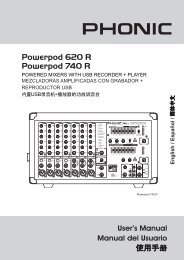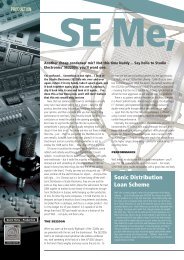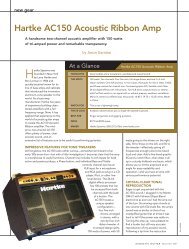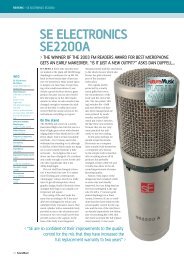Future Music Review - Gemini - Total Sonic
Future Music Review - Gemini - Total Sonic
Future Music Review - Gemini - Total Sonic
You also want an ePaper? Increase the reach of your titles
YUMPU automatically turns print PDFs into web optimized ePapers that Google loves.
REVIEWS SE GEMINI MICROPHONE<br />
Does a doubling of<br />
valves double the<br />
quality?<br />
MICROPHONE<br />
SE <strong>Gemini</strong> valve<br />
condenser microphone<br />
The SE <strong>Gemini</strong> is a valve mic with a difference, but do its twin<br />
valves make it a true star? Trevor Curwen reads the signs...<br />
DETAILS<br />
SE GEMINI<br />
MICROPHONE<br />
PRICE £799<br />
CONTACT<br />
Distributor: <strong>Sonic</strong><br />
Distribution<br />
Tel: 01525 84 0400<br />
Web: www.sonicdistribution.com<br />
TECH SPECS<br />
Frequency Response: 20Hz-<br />
20KHz<br />
Sensitivity: 12.6mV/Pa -<br />
38± 1dB(0dB=1V/Pa<br />
1000Hz)<br />
I<br />
T MAY BE as much about<br />
marketing as sound quality,<br />
but just about every microphone<br />
manufacturer includes a valve<br />
(tube) mic in their inventory these<br />
days. SE Electronics are no<br />
exception with The <strong>Gemini</strong>, on test<br />
here, being one of three valve mics<br />
in their array of eight models.<br />
The <strong>Gemini</strong>, however, is no bogstandard<br />
valve mic (if such a thing<br />
as a bog standard valve mic exists).<br />
While valve mics usually utilise a<br />
single valve in their circuitry, the<br />
<strong>Gemini</strong>, as the name implies, has a<br />
twin valve topography with a pair of<br />
glowing bottles at the business end.<br />
This is a world first according to the<br />
SE blurb. So, does doubling the valve<br />
count double the performance?<br />
Overview<br />
The <strong>Gemini</strong> certainly comes wellpackaged.<br />
All the necessary bits are<br />
held secure in a large foam-lined<br />
aluminium attache case. Power<br />
supply, lead and suspension mount<br />
all have their own slots, while the mic<br />
itself has its own wooden box inside<br />
the case for further protection. The<br />
mic itself is bloody big, cylindrical,<br />
bulbous and as thick as a donkey’s<br />
dongler. With a very weighty (1.3kg)<br />
construction, the bulk of the mic’s<br />
body is heavy brass with a textured<br />
matt grey finish. This is topped off by<br />
a silver coloured top section with a<br />
double layer of basketweave mesh<br />
protecting the gold diaphragm.<br />
The valves can be seen through<br />
a grid of 35 ventilation holes in the<br />
body, but the microphone screws<br />
apart for maintenance purposes, so<br />
it’s possible to get inside and take a<br />
closer look. Inside, the two valves are<br />
plugged into seatings rather than<br />
being soldered in place, so replacing<br />
them would be an easy task should<br />
it be called for. The rest of the<br />
transformerless circuitry looks solid,<br />
neat and tidy so no p roblems there.<br />
<strong>Future</strong><strong>Music</strong> | 57<br />
FMU158.rev_semic 57<br />
21/12/04 7:29:53 pm
REVIEWS SE GEMINI MICROPHONE<br />
ALTERNATIVES<br />
RODE NT K2<br />
£570<br />
The K2 is Rode’s latest valve<br />
mic, an ultra low noise model<br />
with variable polar pattern.<br />
www.rodemicrophones.com<br />
AKG SOLIDTUBE<br />
£749<br />
The Solidtube is AKG’s nearest<br />
equivalent mic. It’s a cardioid<br />
only valve design with bass<br />
rolloff and 20dB pad.<br />
www.akg.com<br />
AUDIO TECHNICA AT3060<br />
£425 FM140 8/8/9/7/7<br />
A cardioid only valve mic that<br />
works from a phantom power<br />
source rather than its own<br />
power supply.<br />
www.audio-technica.co.uk<br />
Connections to the power supply<br />
take place via a 4.5 metre cable,<br />
which is long enough for the power<br />
supply to be kept out of harm’s way<br />
in most miking situations. The cable<br />
fixes into place at both ends by<br />
locating the 8 pins and screwing up<br />
an external collar for a solid bond.<br />
Besides the cable fixing and IEC<br />
mains socket, the power supply box<br />
has just an XLR audio output plus a<br />
simple on/off switch and light. The<br />
<strong>Gemini</strong>, in fact, isn’t blessed with any<br />
of the switchable options that one<br />
might expect of a mic in this price<br />
range. The pickup pattern is cardioid<br />
only, and there is no hi -pass (bass<br />
cut) filter or attenuation pad. On the<br />
latter point, however, the <strong>Gemini</strong><br />
can handle SPLs of up to 130dB,<br />
so won’t exactly be a shrinking violet<br />
when faced with some of the louder<br />
sounds studio life can offer.<br />
In Use<br />
The first job has to be to get the<br />
<strong>Gemini</strong> on a mic stand, but don’t<br />
try it with any cheapo lightweight<br />
stands. The weight of this thing<br />
requires something more substantial.<br />
A threaded mount on the mic body<br />
allows solid connection into the<br />
supplied cradle mount.<br />
Turning the mic on at the PSU,<br />
the green LED flashes on and off for<br />
a few seconds and the mic comes<br />
on with what would probably be a<br />
loud pop through the monitors<br />
THIS IS A MIC THAT CAPTURES<br />
A BIG EXPANSIVE SOUND FROM<br />
A CLOSELY PLACED SOURCE<br />
It really is worth<br />
the cash<br />
should the output be routed to a live<br />
channel. After allowing a short but<br />
reasonable warm up period the mic<br />
is ready for use and it does get very<br />
warm – those 35 holes drilled in the<br />
body aren’t just there to look pretty.<br />
The primary task for this mic will<br />
be to record vocals, and the resulting<br />
sound is very pleasant. This is a<br />
mic that captures a big expansive<br />
sound from a closely placed source.<br />
Recorded vocals have an enhanced<br />
airy breathiness about them,<br />
although not at the expense of other<br />
frequencies, which seem to be<br />
present in the correct proportions<br />
for a naturally balanced sound with<br />
Other SE Mics<br />
The <strong>Gemini</strong> is just one of three Chinese<br />
built valve mics in the SE range, the<br />
others being the ICIS (£349) and the<br />
Z5600A (£399), both of which were<br />
reviewed in FM155. While the ICIS<br />
is another cardioid only device, the<br />
Z5600 has access to nine<br />
different polar patterns,<br />
namely Cardioid, Omni,<br />
Figure of 8, and six<br />
intermediate stages.<br />
The other mics in the SE range<br />
are solid state condensers. Three<br />
of these are small diaphragm<br />
types running from the no frills<br />
cardioid SE1A (£69) and the<br />
cardioid SE3 (£121) with low cut<br />
filter and 10dB pad to the more<br />
expensive SE2A (£149) which is<br />
equipped with cardioid, omni and<br />
hyper-cardioid patterns.<br />
The final two models are large<br />
diaphragm condensers – in terms<br />
of polar patterns, the solid state<br />
counterparts of the ICIS and<br />
Z5600A. The SE2200A (£149)<br />
has a fixed cardioid pattern while the<br />
Z3300A (£298) has cardioid, omni and<br />
figure of 8 options.<br />
plenty of depth. This is borne out by<br />
the frequency response chart which<br />
shows a pretty flat response, but<br />
with a gentle rise in the upper end,<br />
peaking at about 10kHz.<br />
Moving in closer to the mic there<br />
is a definite proximity effect bass lift<br />
manifesting itself as warmth in the<br />
lower mids that the experienced<br />
vocalist can exploit, but there’s<br />
nothing too heavy here, even taking<br />
into account the lack of a physical<br />
low cut filter switch. Overall, on<br />
vocal duties, the mic is capable of<br />
capturing a full-on sound that will<br />
have plenty of presence in the mix.<br />
On acoustic guitars the <strong>Gemini</strong><br />
reproduces all the necessary detail<br />
with no apparent problems. This is<br />
a sensitive mic that has no problems<br />
with the nuances delivered by<br />
vibrating strings at different volume<br />
levels, and captures transient detail<br />
really well. This was particularly<br />
apparent on the 12 string where the<br />
extra high end harmonic detail of the<br />
octave and unison strings confers a<br />
distinctive sheen.<br />
Overall, the <strong>Gemini</strong> delivers a<br />
nicely balanced sound with a more<br />
airy and less subdued high end that<br />
might be typical of a valve mic.<br />
Verdict<br />
So are two valves better than one?<br />
Well, that’s not really the issue<br />
because no matter what a<br />
microphone’s circuitry and<br />
construction happens to be, the<br />
question really has to be how well<br />
does it perform? In the <strong>Gemini</strong>’s<br />
case the answer has to be very well<br />
indeed. You get a full bodied sound<br />
that might be expected from a valve<br />
mic coupled with a clear and<br />
detailed sparkly top end. It’s a great<br />
first choice for vocals, but is capable<br />
of being used on tasks that require a<br />
large diaphragm condenser.<br />
SE are known for their reasonable<br />
pricing, but £799 isn’t exactly budget<br />
territory. Don’t be put off, though, as<br />
it’s not an awful lot to pay for a<br />
microphone that is this good. FM<br />
VERDICT SE GEMINI MIC<br />
BUILD QUALITY<br />
❚❚❚❚❚❚❚❚❚❚<br />
VALUE FOR MONEY<br />
❚❚❚❚❚❚❚❚❚❚<br />
EASE OF USE<br />
❚❚❚❚❚❚❚❚❚❚<br />
VERSATILITY<br />
❚❚❚❚❚❚❚❚❚❚<br />
QUALITY OF RESULTS<br />
❚❚❚❚❚❚❚❚❚❚<br />
2 4 6 8 10<br />
A valve microphone with a<br />
sound of its own that is ideal<br />
for recording upfront vocals.<br />
58 | <strong>Future</strong><strong>Music</strong><br />
FMU158.rev_semic 58<br />
21/12/04 7:30:03 pm







